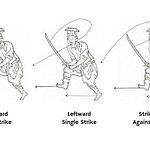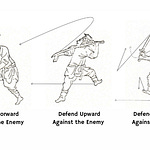Overview: What Are Dynamic Defenses?
In Ssangsudo, defense is never static. It’s not just about stopping a blade—it’s about moving with purpose, redirecting force, and regaining control of the encounter.
The techniques known as Leftward Defense and Rightward Defense go beyond basic side blocks. They are about:
Evasive footwork that slips past danger
Redirections that send the opponent’s power into empty space
Seamless setups for immediate counterattack
These are dynamic defenses—responses that blend precise steps, torso rotation, and blade geometry into one continuous flow. They don’t just defend; they reposition, prepare, and launch the next move.
1. Leftward Defense
You stand in the Confront the Enemy Posture, sword angled and alert.
Imagine an incoming strike sweeps toward your left side.
Instinctively, you step forward, or diagonally left, leading with your left foot. Your hips open naturally into the motion.
As you move, your torso rotates leftward, guiding the sword in a rising diagonal arc, intercepting the strike as you slip aside.
Your spine stays upright, your gaze fixed—you never turn away from the threat.
The movement finishes with the blade angled leftward, edge outward, your body poised and coiled for the counter.
What does this achieve?
You’ve evaded a direct attack—perhaps a thrust or a vertical cut—while redirecting its force across your body. More than just surviving, you’ve set up the next move: a descending cut, a step-through thrust, or a sudden reversal.
2. Rightward Defense
From the final posture of Leftward Defense, the next threat comes—this time from the right.
Without hesitation, you shift your weight and step forward or diagonally right, your right foot leading the motion.
Your torso rotates slightly rightward, drawing the sword across your body in a mirrored arc—again rising diagonally, this time from left to right.
The tip points upward, the edge faces right—forming a protective curve through space.
Your core remains engaged, grounding the motion and preventing over-rotation.
You’ve answered an attack aimed at your right flank—perhaps a shoulder-level slash—with fluidity and control. And once again, the sword finishes in a position ready to strike, holding the initiative firmly in your grasp.
Training Notes for Both Movements
Precision before speed: Let the blade’s path be clear and intentional. Clean technique will always outperform rushed motion.
Weight transfer: Feel the shift as you pivot and move. This transition from back foot to front anchors the movement in stability.
Breathe with rhythm: Inhale on the step, exhale on the cut. Controlled breathing builds stamina and sharpens timing.
Visualize the threat: These are not abstract drills. Imagine the attack—then move in response. That’s how these dynamics come to life.
Why These Dynamics Matter
Leftward and Rightward Defense aren’t isolated techniques. They develop your ability to:
Adapt under pressure
Defend without yielding ground
Transition fluidly into offense
In traditional Korean martial arts, defense is active—never passive. It is a redirection, not a retreat. These techniques embody a central principle:
Train them patiently.
Understand the logic of their motion.
And above all, feel the way your footwork, sword, and intention move as one.













Share this post